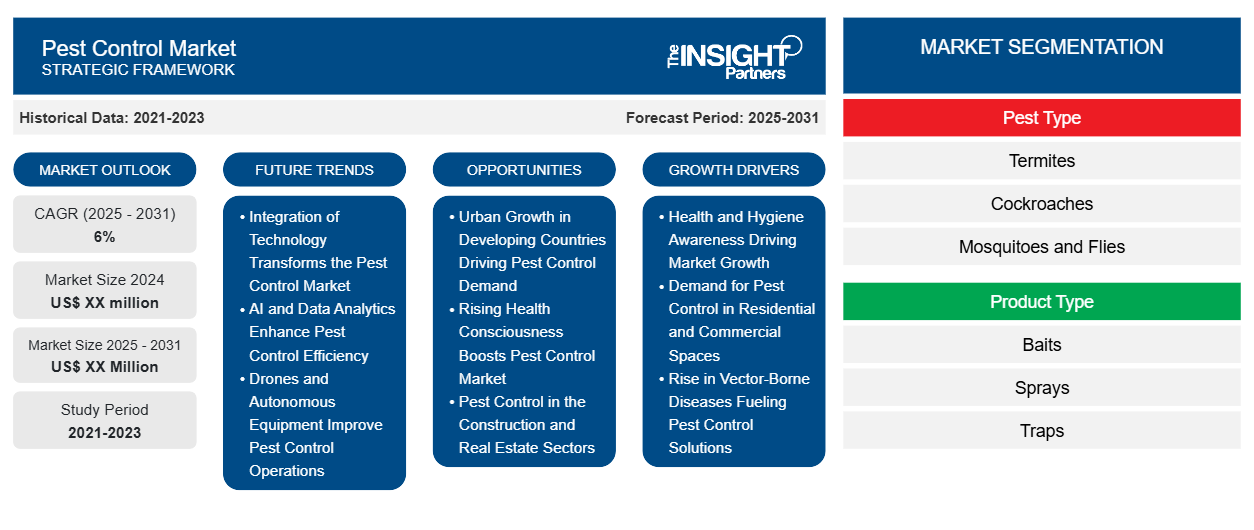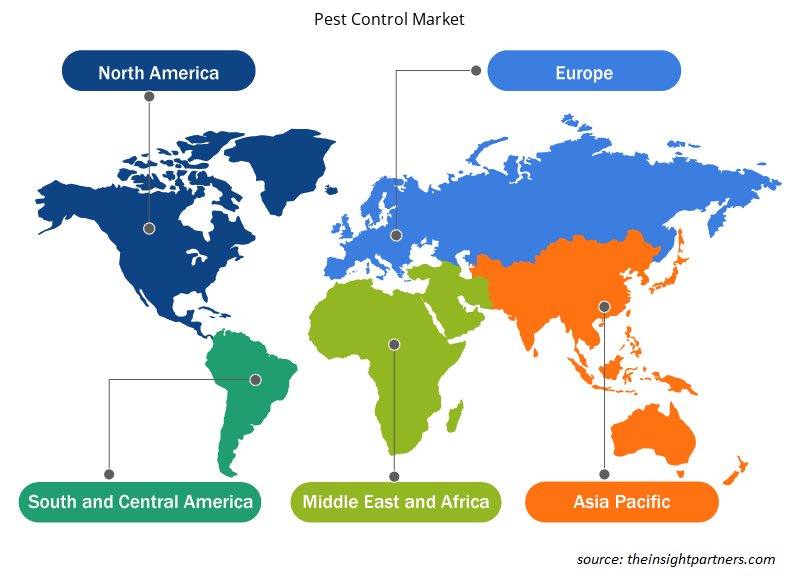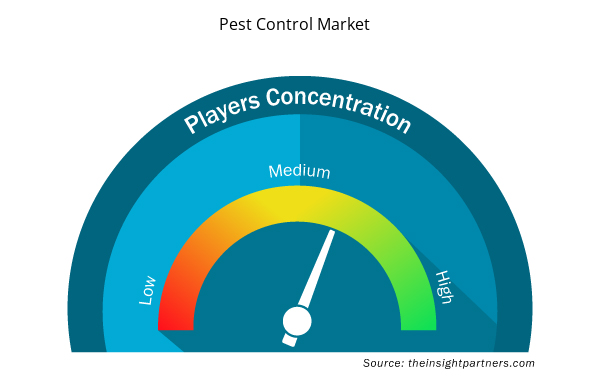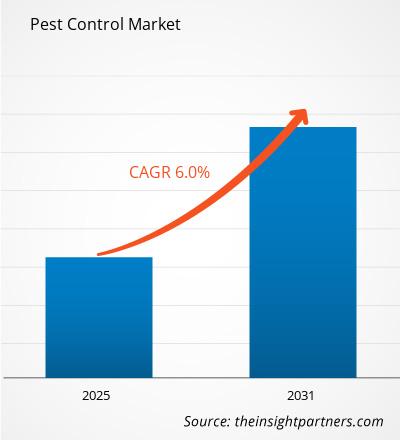Si prevede che il mercato del controllo dei parassiti registrerà un CAGR del 6% dal 2025 al 2031, con una dimensione di mercato in espansione da XX milioni di dollari nel 2024 a XX milioni di dollari entro il 2031.
Il rapporto presenta un'analisi basata sul tipo di parassita (termiti, scarafaggi, zanzare e mosche, roditori e altri). Il rapporto è segmentato per tipo di prodotto (esche, spray, trappole, polvere e altri). Il rapporto è segmentato per uso finale (residenziale, commerciale, industriale e altri). L'analisi globale è ulteriormente suddivisa a livello regionale e nei principali paesi. Le dimensioni del mercato e le previsioni a livello globale, regionale e nazionale per tutti i principali segmenti di mercato sono coperte nell'ambito. Il rapporto offre il valore in USD per l'analisi e i segmenti di cui sopra. Il rapporto fornisce statistiche chiave sullo stato di mercato dei principali attori del mercato e offre tendenze e opportunità di mercato.
Scopo del rapporto
Il report Pest Control Market di The Insight Partners mira a descrivere il panorama attuale e la crescita futura, i principali fattori trainanti, le sfide e le opportunità. Ciò fornirà spunti a vari stakeholder aziendali, come:
- Fornitori/produttori di tecnologia: per comprendere le dinamiche di mercato in evoluzione e conoscere le potenziali opportunità di crescita, consentendo loro di prendere decisioni strategiche informate.
- Investitori: condurre un'analisi completa delle tendenze relative al tasso di crescita del mercato, alle proiezioni finanziarie del mercato e alle opportunità esistenti lungo la catena del valore.
- Enti di regolamentazione: regolamentano le politiche e le attività di controllo sul mercato allo scopo di ridurre al minimo gli abusi, preservare la fiducia degli investitori e sostenere l'integrità e la stabilità del mercato.
Segmentazione del mercato del controllo dei parassiti
Tipo di parassita
- Termiti
- Scarafaggi
- Zanzare e mosche
- Roditori
- Altri
Tipo di prodotto
- Esche
- Spruzzi
- Trappole
- Polvere
- Altri
Uso finale
- Residenziale
- Commerciale
- Industriale
- Altri
Geografia
- America del Nord
- Europa
- Asia-Pacifico
- America del Sud e Centro
- Medio Oriente e Africa
Personalizza questo report in base alle tue esigenze
Riceverai la personalizzazione gratuita di qualsiasi report, comprese parti di questo report, o analisi a livello nazionale, pacchetto dati Excel, oltre a usufruire di grandi offerte e sconti per start-up e università
Mercato del controllo dei parassiti: approfondimenti strategici

- Scopri le principali tendenze di mercato in questo rapporto.Questo campione GRATUITO includerà analisi di dati che spaziano dalle tendenze di mercato alle stime e alle previsioni.
Fattori trainanti della crescita del mercato del controllo dei parassiti
- La consapevolezza della salute e dell'igiene guida la crescita del mercato: la crescita del mercato è influenzata in modo significativo dalla consapevolezza della salute e dell'igiene. Oggi, consumatori e aziende si stanno impegnando molto per evitare i parassiti e cercano soluzioni di gestione dei parassiti per aumentare la consapevolezza globale dei rischi per la salute associati ai parassiti. Parassiti come roditori, zanzare e scarafaggi, noti e documentati portatori di malattie, contribuiscono quindi ad aumentare la domanda di servizi di controllo dei parassiti.
- Domanda di disinfestazione in spazi residenziali e commerciali: con una maggiore consapevolezza pubblica di igiene e malattie, c'è stata quindi una domanda di disinfestazione in aree residenziali e commerciali. Con tali mosse da parte di questa industria alimentare, istituzioni sanitarie e aziende alberghiere, si concentrano sulla gestione dei parassiti, creando ambienti igienici che proteggeranno i clienti e i dipendenti da potenziali rischi per la salute.
- Aumento delle malattie trasmesse da vettori che alimentano le soluzioni di controllo dei parassiti: le malattie trasmesse da vettori, come zanzare e zecche, sono aumentate ulteriormente per implementare soluzioni di controllo dei parassiti. Le crescenti campagne di sensibilizzazione su malattie come la malaria, la dengue e il virus Zika hanno incoraggiato persone e governi a spendere soldi in metodi efficaci di gestione dei parassiti, stimolando ulteriormente la crescita del mercato.
Tendenze future del mercato del controllo dei parassiti
- L'integrazione della tecnologia trasforma il mercato del controllo dei parassiti: l'integrazione della tecnologia è una delle tendenze in più rapida evoluzione che cambia il mercato del controllo dei parassiti. I rivoluzionari sistemi intelligenti per il controllo dei parassiti, come i dispositivi abilitati IoT, hanno trasformato il monitoraggio e la gestione dei parassiti rendendo possibile il tracciamento in tempo reale dell'attività dei parassiti. Ciò consente interventi più efficaci e tempestivi per clienti residenziali e commerciali.
- L'intelligenza artificiale e l'analisi dei dati migliorano l'efficienza del controllo dei parassiti: i progressi nell'analisi dei dati e nell'intelligenza artificiale continuano a migliorare il controllo dei parassiti. Gli strumenti di rilevamento precoce basati sull'intelligenza artificiale possono rilevare meglio le infestazioni molto prima e identificarle con maggiore precisione, con conseguenti trattamenti mirati per ridurre al minimo l'uso di sostanze chimiche. Tali risultati portano a una gestione dei parassiti ancora più efficiente ed ecologica, che attrae i consumatori consapevoli sul mercato.
- Droni e attrezzature autonome migliorano le operazioni di controllo dei parassiti: c'è anche la nuova applicazione di droni e altre attrezzature autonome per il controllo dei parassiti. I droni sono già stati applicati in sistemi agricoli su larga scala come monitor aerei per esplorare la popolazione di parassiti e le aree che necessitano di trattamento. Questa tecnologia aumenta l'efficienza nelle operazioni, riduce le spese di manodopera e porta a pratiche più accurate di gestione dei parassiti in agricoltura e nelle città.
Opportunità di mercato per il controllo dei parassiti
- Crescita urbana nei paesi in via di sviluppo che spinge la domanda di controllo dei parassiti: un numero significativo di paesi in via di sviluppo sta sperimentando alti tassi di crescita della popolazione urbana e molti hanno un grande potenziale per supportare la crescita dei mercati del controllo dei parassiti. Questi fattori tendono ad aumentare la necessità di una gestione efficace del controllo dei parassiti all'interno della città per popolazioni elevate. La gestione dei servizi igienici o dei rifiuti spesso si rivela difficile e aumenta l'infestazione di parassiti all'interno delle città e, quindi, le persone cercherebbero di assumere professionisti per controllare le condizioni dei parassiti.
- La crescente consapevolezza della salute stimola il mercato del controllo dei parassiti: una maggiore prosperità nelle economie in via di sviluppo ha portato a una maggiore consapevolezza dell'igiene e della salute tra la classe media urbana. Con un aumento del reddito disponibile, i consumatori sono disposti a spendere di più in prodotti e servizi per il controllo dei parassiti per proteggere le loro case, aziende e spazi pubblici. Ciò, a sua volta, sta portando a una maggiore domanda di soluzioni per il controllo dei parassiti nei mercati residenziali e commerciali.
- Controllo dei parassiti nei settori edilizio e immobiliare: l'altra categoria è quella dei settori edilizio e immobiliare delle nazioni in via di sviluppo. Gli edifici di nuova costruzione, specialmente nelle aree in cui le città sono in crescita, danno origine a infestazioni di parassiti durante e dopo la costruzione. Pertanto, i servizi di controllo dei parassiti sono sempre necessari prima e dopo la costruzione di nuovi sviluppi e città già esistenti.
Approfondimenti regionali sul mercato del controllo dei parassiti
Le tendenze regionali e i fattori che influenzano il mercato del controllo dei parassiti durante il periodo di previsione sono stati ampiamente spiegati dagli analisti di Insight Partners. Questa sezione discute anche i segmenti e la geografia del mercato del controllo dei parassiti in Nord America, Europa, Asia Pacifico, Medio Oriente e Africa e Sud e Centro America.

- Ottieni i dati specifici regionali per il mercato del controllo dei parassiti
Ambito del rapporto sul mercato del controllo dei parassiti
| Attributo del report | Dettagli |
|---|---|
| Dimensioni del mercato nel 2024 | XX milioni di dollari USA |
| Dimensioni del mercato entro il 2031 | XX milioni di dollari USA |
| CAGR globale (2025 - 2031) | 6% |
| Dati storici | 2021-2023 |
| Periodo di previsione | 2025-2031 |
| Segmenti coperti | Per tipo di parassita
|
| Regioni e Paesi coperti | America del Nord
|
| Leader di mercato e profili aziendali chiave |
|
Densità degli operatori del mercato del controllo dei parassiti: comprendere il suo impatto sulle dinamiche aziendali
Il mercato del controllo dei parassiti sta crescendo rapidamente, spinto dalla crescente domanda degli utenti finali dovuta a fattori quali l'evoluzione delle preferenze dei consumatori, i progressi tecnologici e una maggiore consapevolezza dei benefici del prodotto. Con l'aumento della domanda, le aziende stanno ampliando le loro offerte, innovando per soddisfare le esigenze dei consumatori e capitalizzando sulle tendenze emergenti, il che alimenta ulteriormente la crescita del mercato.
La densità degli operatori di mercato si riferisce alla distribuzione di aziende o società che operano in un particolare mercato o settore. Indica quanti concorrenti (operatori di mercato) sono presenti in un dato spazio di mercato in relazione alle sue dimensioni o al valore di mercato totale.
Le principali aziende che operano nel mercato del controllo dei parassiti sono:
- Disinfestatori di frecce
- BASF SE
- Società per azioni Bayer
- Ecolab
- Ensystex
Disclaimer : le aziende elencate sopra non sono classificate secondo un ordine particolare.

- Ottieni una panoramica dei principali attori del mercato del controllo dei parassiti
Punti chiave di vendita
- Copertura completa: il rapporto esamina in modo completo i prodotti, i servizi, le tipologie e gli utenti finali del mercato del controllo dei parassiti, fornendo una panoramica olistica.
- Analisi degli esperti: il rapporto è compilato sulla base della conoscenza approfondita di esperti e analisti del settore.
- Informazioni aggiornate: il rapporto garantisce la pertinenza aziendale grazie alla copertura di informazioni recenti e tendenze nei dati.
- Opzioni di personalizzazione: questo report può essere personalizzato per soddisfare le esigenze specifiche del cliente e adattarsi in modo appropriato alle strategie aziendali.
Il rapporto di ricerca sul mercato del controllo dei parassiti può, quindi, aiutare a guidare il percorso di decodificazione e comprensione dello scenario del settore e delle prospettive di crescita. Sebbene possano esserci alcune preoccupazioni valide, i vantaggi complessivi di questo rapporto tendono a superare gli svantaggi.
- Analisi storica (2 anni), anno base, previsione (7 anni) con CAGR
- Analisi PEST e SWOT
- Valore/volume delle dimensioni del mercato - Globale, regionale, nazionale
- Industria e panorama competitivo
- Set di dati Excel



Report Coverage
Revenue forecast, Company Analysis, Industry landscape, Growth factors, and Trends

Segment Covered
This text is related
to segments covered.

Regional Scope
North America, Europe, Asia Pacific, Middle East & Africa, South & Central America

Country Scope
This text is related
to country scope.
Domande frequenti
Technology integration are expected to be the key market trends.
Based on product type, the baits segment is expected to witness the fastest growth during the forecast period
Based on geography, North America held the largest share of the pest control market due to high consumer awareness of health and hygiene, advanced pest control technologies, and stringent regulatory standards that promote safe and effective pest management.
Health and hygiene awareness is driving the market growth.
BASF SE; Environmental Science US Inc; FMC Corporation; Fort Products Ltd; Liphatech Inc; Neogen Corp; Nihon Nohyaku Co Ltd; PelGar International; Sumitomo Chemical Co Ltd; and Syngenta AG are some of the key players operating in the pest control market
The Pest Control Market is estimated to witness a CAGR of 6% from 2023 to 2031
Trends and growth analysis reports related to Chemicals and Materials : READ MORE..
1. Arrow Exterminators
2. BASF SE
3. Bayer AG
4. Ecolab
5. Ensystex
6. FMC Corporation
7. Lindsey Pest Services
8. Rollins, Inc.
9. Syngenta
10. The Terminix International Company Limited Partnership
The Insight Partners performs research in 4 major stages: Data Collection & Secondary Research, Primary Research, Data Analysis and Data Triangulation & Final Review.
- Data Collection and Secondary Research:
As a market research and consulting firm operating from a decade, we have published and advised several client across the globe. First step for any study will start with an assessment of currently available data and insights from existing reports. Further, historical and current market information is collected from Investor Presentations, Annual Reports, SEC Filings, etc., and other information related to company’s performance and market positioning are gathered from Paid Databases (Factiva, Hoovers, and Reuters) and various other publications available in public domain.
Several associations trade associates, technical forums, institutes, societies and organization are accessed to gain technical as well as market related insights through their publications such as research papers, blogs and press releases related to the studies are referred to get cues about the market. Further, white papers, journals, magazines, and other news articles published in last 3 years are scrutinized and analyzed to understand the current market trends.
- Primary Research:
The primarily interview analysis comprise of data obtained from industry participants interview and answers to survey questions gathered by in-house primary team.
For primary research, interviews are conducted with industry experts/CEOs/Marketing Managers/VPs/Subject Matter Experts from both demand and supply side to get a 360-degree view of the market. The primary team conducts several interviews based on the complexity of the markets to understand the various market trends and dynamics which makes research more credible and precise.
A typical research interview fulfils the following functions:
- Provides first-hand information on the market size, market trends, growth trends, competitive landscape, and outlook
- Validates and strengthens in-house secondary research findings
- Develops the analysis team’s expertise and market understanding
Primary research involves email interactions and telephone interviews for each market, category, segment, and sub-segment across geographies. The participants who typically take part in such a process include, but are not limited to:
- Industry participants: VPs, business development managers, market intelligence managers and national sales managers
- Outside experts: Valuation experts, research analysts and key opinion leaders specializing in the electronics and semiconductor industry.
Below is the breakup of our primary respondents by company, designation, and region:

Once we receive the confirmation from primary research sources or primary respondents, we finalize the base year market estimation and forecast the data as per the macroeconomic and microeconomic factors assessed during data collection.
- Data Analysis:
Once data is validated through both secondary as well as primary respondents, we finalize the market estimations by hypothesis formulation and factor analysis at regional and country level.
- Macro-Economic Factor Analysis:
We analyse macroeconomic indicators such the gross domestic product (GDP), increase in the demand for goods and services across industries, technological advancement, regional economic growth, governmental policies, the influence of COVID-19, PEST analysis, and other aspects. This analysis aids in setting benchmarks for various nations/regions and approximating market splits. Additionally, the general trend of the aforementioned components aid in determining the market's development possibilities.
- Country Level Data:
Various factors that are especially aligned to the country are taken into account to determine the market size for a certain area and country, including the presence of vendors, such as headquarters and offices, the country's GDP, demand patterns, and industry growth. To comprehend the market dynamics for the nation, a number of growth variables, inhibitors, application areas, and current market trends are researched. The aforementioned elements aid in determining the country's overall market's growth potential.
- Company Profile:
The “Table of Contents” is formulated by listing and analyzing more than 25 - 30 companies operating in the market ecosystem across geographies. However, we profile only 10 companies as a standard practice in our syndicate reports. These 10 companies comprise leading, emerging, and regional players. Nonetheless, our analysis is not restricted to the 10 listed companies, we also analyze other companies present in the market to develop a holistic view and understand the prevailing trends. The “Company Profiles” section in the report covers key facts, business description, products & services, financial information, SWOT analysis, and key developments. The financial information presented is extracted from the annual reports and official documents of the publicly listed companies. Upon collecting the information for the sections of respective companies, we verify them via various primary sources and then compile the data in respective company profiles. The company level information helps us in deriving the base number as well as in forecasting the market size.
- Developing Base Number:
Aggregation of sales statistics (2020-2022) and macro-economic factor, and other secondary and primary research insights are utilized to arrive at base number and related market shares for 2022. The data gaps are identified in this step and relevant market data is analyzed, collected from paid primary interviews or databases. On finalizing the base year market size, forecasts are developed on the basis of macro-economic, industry and market growth factors and company level analysis.
- Data Triangulation and Final Review:
The market findings and base year market size calculations are validated from supply as well as demand side. Demand side validations are based on macro-economic factor analysis and benchmarks for respective regions and countries. In case of supply side validations, revenues of major companies are estimated (in case not available) based on industry benchmark, approximate number of employees, product portfolio, and primary interviews revenues are gathered. Further revenue from target product/service segment is assessed to avoid overshooting of market statistics. In case of heavy deviations between supply and demand side values, all thes steps are repeated to achieve synchronization.
We follow an iterative model, wherein we share our research findings with Subject Matter Experts (SME’s) and Key Opinion Leaders (KOLs) until consensus view of the market is not formulated – this model negates any drastic deviation in the opinions of experts. Only validated and universally acceptable research findings are quoted in our reports.
We have important check points that we use to validate our research findings – which we call – data triangulation, where we validate the information, we generate from secondary sources with primary interviews and then we re-validate with our internal data bases and Subject matter experts. This comprehensive model enables us to deliver high quality, reliable data in shortest possible time.

 Ottieni un campione gratuito per questo repot
Ottieni un campione gratuito per questo repot